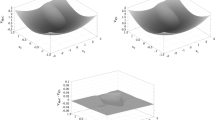Abstract
A method is proposed for solving the two-point boundary-value problem occurring in discrete-time linear-quadratic Stackelberg games. It is shown that, for open-loop information structure, the necessary conditions can be ordered to form a symplectic matrix. The solution is then obtained by exploiting the properties of such a matrix.
Similar content being viewed by others
References
Chen, C. I., andCruz, J. B.,Stackelberg Solution for Two-Person Games with Biased Information Patterns, IEEE Transactions on Automatic Control, Vol. 17, pp. 791–797, 1972.
Simaan, M., andCruz, J. B.,On the Stackelberg Strategy in Nonzero-Sum Games, Journal of Optimization Theory and Applications, Vol. 11, pp. 533–555, 1973.
Basar, T., andOlsder, G. J.,Dynamic Noncooperative Game Theory, Academic Press, New York, New York, 1982.
Abou-Kandil, H., andBertrand, P.,Analytic Solution for an Open-Loop Stackelberg Game, IEEE Transactions on Automatic Control, Vol. 30, pp. 1222–1224, 1985.
Author information
Authors and Affiliations
Additional information
Communicated by M. Simaan
Rights and permissions
About this article
Cite this article
Abou-Kandil, H. Closed-form solution for discrete-time linear-quadratic Stackelberg games. J Optim Theory Appl 65, 139–147 (1990). https://doi.org/10.1007/BF00941165
Issue Date:
DOI: https://doi.org/10.1007/BF00941165




